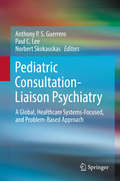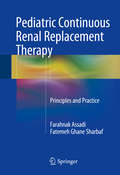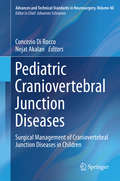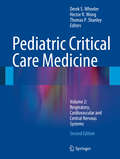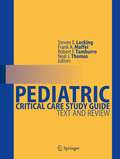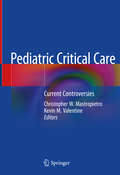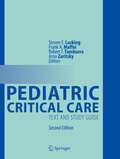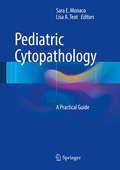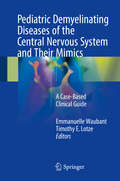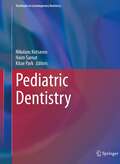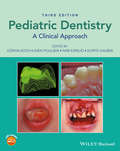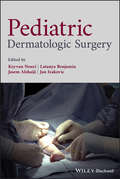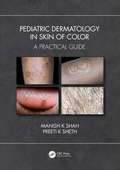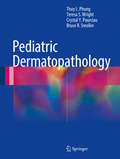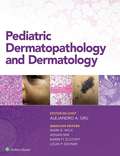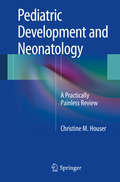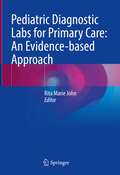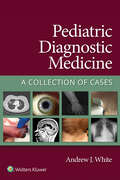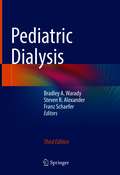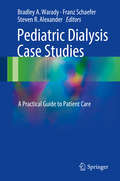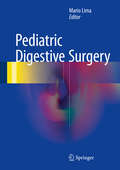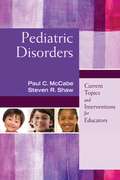- Table View
- List View
Pediatric Consultation-Liaison Psychiatry: A Global, Healthcare Systems-Focused, and Problem-Based Approach
by Anthony P. Guerrero Paul C. Lee Norbert SkokauskasThis ambitious resource presents an inventive approach to integrating pediatric and mental health care based in comprehensive, family-centered service delivery. Its framework adds a problem-solving focus to the core principles of pediatric consultation-liaison psychiatry, emphasizing young patients’ developmental, family, and social context. An international panel of expert clinicians explores the value of the mental health component in treating complex and chronic cases across varied settings, as well as practical considerations in implementing collaborative pediatric care systemwide, including at the global level. Detailed case histories illustrate skills and traits essential to making this problem-based approach work, such as multidimensional thinking, a prevention mentality, a dedication to lifelong learning, and empathy and respect for young clients and their families. Included in the coverage: · Pediatric medicine for the child psychiatrist. · Safety issues in a general medical facility setting. · “Other medical” presentations and considerations in pediatric consultation-liaison psychiatry. · Principles of biopsychosocial formulation and interventions in the pediatric medical setting. · Preventive models for reducing major causes of morbidity and mortality in childhood. Child and adolescent psychiatrists, child and school psychologists, and physicians in pediatrics, general practice, and family medicine will welcome Pediatric Consultation-Liaison Psychiatry as both a robust training text and a blueprint for the future of children’s medicine.
Pediatric Continuous Renal Replacement Therapy
by Farahnak Assadi Fatemeh Ghane SharbafThis book provides a current understanding of Continuous Renal Replacement Therapies (CRRT) techniques with a focus on drug dosing in critically ill children receiving CRRT. Strategies include the role of therapeutic drug monitoring, effect of CRRT on drug pharmacokinetics, variations in the drugs properties, newer kidney injury biomarkers and simple and easy methods for estimating drug clearance. The conclusion of this book features case reports focused on the patients' symptoms and laboratory data as they present in clinical practice and the type of CRRT modality needed to provide quality, safety, and cost-effectiveness of patient care. Pediatric Continuous Renal Replacement Therapy will expand the clinical knowledge and experience of practicing nephrologists and other professionals involved in the care of children suffering from Acute Kidney Injury (AKI) to improve and sustain their quality of life.
Pediatric Craniovertebral Junction Diseases
by Nejat Akalan Concezio RoccoThis dedicated volume in the series Advances and Technical Standards in Neurosurgery (ATSN) provides a comprehensive approach to diseases of the craniovertebral junction (CVJ) and their management based on the multidisciplinary cooperation of neurosurgeons, anatomists, neuroradiologists, and neuroanesthesiologists. The contributing authors represent the most renowned clinical and surgical experts from Europe and beyond. The main topics highlighted are embryology, normal and abnormal development of the CVJ, including the related vessels, modern radiological contributions to diagnosis, genetic and metabolic factors which may impact on the surgical strategies, the opportunities offered by traditional operative techniques, and the recently introduced minimally invasive and endoscopic surgical modalities. Special emphasis is also placed on the evolution of the principles of surgical treatment as matured during the past decade by experiences in the still open field of pediatric neurosurgery.
Pediatric Critical Care Medicine
by Derek S. Wheeler Hector R. Wong Thomas P. ShanleyThe second edition of Pediatric Critical Care Medicine spans three volumes, with major sections dedicated to specific organ systems. Each major section consists of separate chapters dedicated to reviewing the specific disease processes affecting each organ system Each chapter concludes with a comprehensive list of references, with brief, concise remarks denoting references of 'special interest' and 'of interest' Consequently, the books are unique in their comprehensive coverage of pediatric critical care and their ease of use and will be of value to those studying towards pediatric critical care examinations and those who are already qualified.
Pediatric Critical Care Medicine
by Derek S. Wheeler Hector R. Wong Thomas P. ShanleyThis second edition spans four volumes, with major sections dedicated to specific organ systems. Each major section consists of separate chapters dedicated to reviewing the specific disease processes affecting each organ system. Each chapter concludes with a comprehensive list of references, with brief, concise remarks denoting references of 'special interest' and 'of interest'. Consequently, the books are unique in their comprehensive coverage of pediatric critical care and their ease of use and will be of value to those studying towards pediatric critical care examinations and those who are already qualified.
Pediatric Critical Care Study Guide
by Robert F. Tamburro Steven E. Lucking Frank A. Maffei Neal J. ThomasThis is the first comprehensive study guide covering all aspects of pediatric critical care medicine. It fills a void that exists in learning resources currently available to pediatric critical care practitioners. The major textbooks are excellent references, but do not allow concise reading on specific topics and are not intended to act as both text and study guide. There are also several handbooks available, but these are usually written for general pediatric residents and lack the advanced physiology and pathophysiology required for the higher level pediatric critical care practitioner
Pediatric Critical Care: Current Controversies
by Christopher W. Mastropietro Kevin M. ValentineThis volume provides an overview of the most important current controversies in the field of pediatric intensive care. Organized into sections based on organ systems, the text focuses on controversies surrounding disease processes of the cardiac, respiratory, gastrointestinal, hematologic / immunologic, endocrine, and neurologic systems. Each chapter reviews the pros and cons of specific management approaches through case studies and the most up-to-date evidence-based resources, and concludes with bulleted take-home points for ease of use. Written by experts in the field, Pediatric Critical Care: Current Controversies is a valuable resource for intensivists, advanced practice providers, nurses, and other health care providers involved in the care of critically-ill children.
Pediatric Critical Care: Text and Study Guide
by Robert F. Tamburro Steven E. Lucking Frank A. Maffei Arno ZaritskyThis extensively updated textbook is a comprehensive study guide that covers pediatric critical care principles and specific disease entities commonly encountered by the pediatric critical care medicine (PCCM) practitioner. Pathophysiologic aspects unique to the pediatric patient are emphasized. The first edition has become a highly utilized text for pediatric critical care fellows. The second edition will prove even more valuable to the fellow in-training and indeed to any clinical pediatric intensivist. In addition to updating the chapters from the previous edition, there are new chapters on topics such as central nervous structure and function, palliative care, child abuse and practical biostatistics. Pediatric Critical Care: Text and Study Guide is an invaluable clinically focused resource for PCCM practitioners. Allowing for concise reading on specific topics, this book acts as both text and study guide covering advanced physiology, pathophysiology, diagnostic considerations and treatment approaches that should be mastered by the higher level PCCM practitioner.The large number of illustrations complements the text in each chapter that also includes key references and case-orientated questions that help reinforce important ideas learned in the chapter.
Pediatric Cytopathology
by Sara E. Monaco Lisa A. TeotThis text presents serious challenges for trainees, clinicians, and practicing pathologists and cytopathologists due to the wide spectrum of diagnoses that may be seen in children and the lack of familiarity with these entities. This reference book has been designed as a practical, high-yield review of pediatric cytopathology. Key findings are highlighted and up-to-date information is provided on the diagnosis of pediatric lesions by cytology, with extensive guidance on differential diagnosis. The book includes tables and full-color images of the cytomorphology and ancillary studies, as well as pertinent histological correlation and guidance on technical issues. Pediatric Cytopathology: A Practical Guide will be an essential reference for anyone interested in the cytomorphological findings in childhood diseases.
Pediatric Demyelinating Diseases of the Central Nervous System and Their Mimics
by Emmanuelle Waubant Timothy E. LotzeThis collection of pediatric clinical cases focus on multiple sclerosis, neuromyelitis optica, acute disseminated encephalomyelitis and mimics. Dedicated sections on diseases affecting the brain, brainstem, spinal cord and the optic nerve feature chapters that include the diagnostic work up, therapeutic management and case outcome. Typical and atypical presentations of various pediatric demyelinating diseases also emphasize therapy response and those that breakthrough on treatment. Filling a critical gap in the literature on inflammatory disorders of the central nervous system, all those that treat patients with these rare and challenging disorders will find this book extremely helpful for their daily clinical practice.
Pediatric Dentistry (Textbooks in Contemporary Dentistry)
by Nikolaos Kotsanos Haim Sarnat Kitae ParkThis textbook provides dental practitioners and students with all the knowledge required in order to treat optimally the oral conditions encountered in children and adolescents and to offer appropriate guidance on subsequent oral health self-care. The opening chapters are designed to assist readers in providing empathic care on the basis of a sound understanding of the processes of physical and psychological maturation. The use of sedation and anesthesia is then discussed, followed by detailed information on such key topics as tooth eruption and shedding, preventive and interceptive orthodontics, and control of dental caries. Restoration procedures and pulp treatment necessitated by dental caries, trauma and/or developmental anomalies are clearly described, with reference to relevant advances in dental technology and materials. Subsequent chapters focus on conditions compromising dental or general oral health in the pediatric age group, such as periodontal diseases, dental wear, dental anomalies, TMJ disorders, and soft tissue lesions. The book concludes by examining treatment approaches in children and adolescents with disabilities, syndromes, chronic diseases, craniofacial abnormalities, and generally advocating children centered dentistry as it affects their quality of life.
Pediatric Dentistry: A Clinical Approach
by Ivar Espelid Goran Koch Sven Poulsen Dorte HaubekNew edition of a leading textbook providing a uniquely clear, comprehensive, and clinical approach to the dental treatment of children and adolescents Offers systematic coverage of all clinical, scientific and social topics relating to pediatric dentistry Thoroughly revised and updated new edition, with an increased focus on evidence based care Includes three new chapters on genetics, child abuse and neglected children, and ethics Pedodontic endodontics is now covered by two chapters - one on primary teeth and one on young permanent teeth Features a companion website with interactive self-assessment questions
Pediatric Dermatologic Surgery
by Keyvan Nouri Latanya Benjamin Jasem Alshaiji Jan IzakovicA complete guide to the surgical techniques used to treat childhood skin conditions Recent advances have expanded the role of pediatric dermatologic surgery in both specialist and primary care settings. However, such surgeries can pose unique challenges to trainees and experienced practitioners alike. Procedures are carried out under local anesthesia and can be a source of distress and concern among young patients. Moreover, child’s skin poses its own set of complicating factors, making the business of performing these procedures especially delicate and precise. This book provides a step-by-step primer on invasive and non-invasive treatments of childhood skin disorders, offering concise and clearly illustrated guidance on current methods and best practices. Addressing conditions’ effects, the impact of recent developments in their treatment, the ethics of operative procedures on children, and multiple treatment options for childhood dermatologic disease, Pediatric Dermatologic Surgery is an indispensable resource for trainee dermatologists and pediatricians, as well as practicing specialists.
Pediatric Dermatology in Skin of Color: A Practical Guide
by Manish K Shah Preeti K ShethThis book focusses on the clinical aspects and management of pediatric skin disorders, especially seen in darker skin types. It includes unique conditions that the authors have encountered in their lifetime with their independent observations and approach to management. Original high-quality images are used to illustrate most dermatoses described in the book enabling a strong visual impression of the discussed diseases. It hopes to provide readers with a blend of evidence and experience based pediatric dermatology. This book aims to be a hands-on manual that can be referred to during a busy practice as it discusses the practical approach to dermatoses. Key Features Focusses on darker skin types. Examines unusual presentations with detailed clinical features. Discusses the ways to differentiate between similar-appearing diseases. Explores approaches to therapy, especially in resource-poor settings. Covers topics with high quality illustrations.
Pediatric Dermatopathology
by Bruce R. Smoller Thuy L. Phung Teresa S. Wright Crystal Y. PourciauThis book provides practicing pathologists, dermatologists, cutaneous oncologists and dermatopathologists with a reference textbook that reviews the clinical and histopathologic features of skin disorders that affect children, along with a discussion of the molecular pathogenesis for each disease as it is currently known. The book includes a concise discussion of the clinical presentation, as well as the histologic and, when appropriate, immunohistochemical features of each disease. The book is divided into two main sections, non-neoplastic and neoplastic skin diseases. Each section is comprised of a series of chapters organized according to histologic findings rather than by clinical classification systems. This will enable the practicing pathologist to browse chapters based upon observation of routine histologic patterns. Each chapter addresses the differential diagnoses of skin disorders with focus on salient histologic characteristics. The text is richly illustrated with over 1000 colorful clinical and histologic photographs for each of the 400 entities discussed. Pediatric Dermatopathology provides a microscope table reference for the practicing pediatric pathologist, general pathologist and dermatopathologist. Further, it will serve as a reference volume for dermatologists, pediatricians and oncologic surgeons.
Pediatric Dermatopathology and Dermatology
by Mark Wick Alejandro A. GruPublisher's Note: Products purchased from 3rd Party sellers are not guaranteed by the Publisher for quality, authenticity, or access to any online entitlements included with the product. Pediatric Dermatopathology and Dermatology is a unique reference highlighting both the histopathology and clinical presentation of common and uncommon pediatric skin disorders. This user-friendly reference is ideal for dermatopathologists and pathologists and of special interest to pediatric dermatologists and general dermatologists. With a global perspective, skin disorders that affect children world-wide are presented. Thousands of full-color histopathology slides and clinical photos accompany concise, templated text for each pediatric skin disorder.
Pediatric Development and Neonatology
by Christine M. HouserOften, information in review books can raise as many questions as it answers. This interferes with the study process, because the learner must either look up additional information or skip ahead without truly comprehending what he or she has read. As an alternative, Pediatric Development and Neonatology: A Practically Painless Review presents bite-sized chunks of information that can be read and processed rapidly, helping learners to stay active while studying to understand and process new information the first time they read it. This book's question and answer format allows for self-testing or study with a partner or a group. The format also facilitates dipping into the book during a few minutes of downtime at the hospital or office. Pediatric Development and Neonatology: A Practically Painless Review is a quick and easy way to master these tricky topics and is suitable for those studying for the pediatric board exam, practicing physicians brushing up on their skills, medical students and pediatric residents doing rotations, and any busy clinician who wants to learn more about these topics while on the go.
Pediatric Diagnostic Labs for Primary Care: An Evidence-based Approach
by Rita Marie JohnThis textbook helps nurses, physician assistants, medical students and residents to order appropriate tests and understand how to interpret them to improve their diagnostic reasoning. Children are not like adults, and interpreting of the results of their diagnostic laboratory tests requires knowledge of the biochemical and metabolic differences. Using a combination of information, questions and case studies, the book allows readers to gain an understanding of the key concepts of sensitivity, specificity, and positive and negative predictive values, as well as the indications for diagnostic lab tests. This textbook presents the state of art in testing across body systems and guidance on how to order and interpret diagnostic laboratory tests in pediatric patients. Each chapter includes learning objectives, tables and figures, as well as questions and references for further learning. This textbook provides an update for clinicians and is a valuable learning tool for students and new clinicians. .
Pediatric Diagnostic Medicine: A Collection of Cases
by Andrew WhiteUsing a practical, case-based presentation, Pediatric Diagnostic Medicine helps you develop diagnostic skills, gain further knowledge through interesting cases, and improve critical thinking to reach a correct diagnosis. Dr. Andrew J. White, vice chair of education and director of the residency program at Washington University in St. Louis, presents dozens of real-world cases highlighted by full-color photographs. This unique case collection is an invaluable resource for pediatricians, residents, hospitalists, physician assistants, nurse practitioners, and anyone who provides care to children.
Pediatric Dialysis
by Bradley A Warady Steven R. Alexander Franz SchaeferSince the inaugural publication of Pediatric Dialysis in 2004, a wide range of advances have taken place in dialysis-related care, leading to a wealth of new knowledge in the field. Pediatric Dialysis, Second Edition brings this knowledge together to provide the most comprehensive source of state-of-the-art information on the dialysis of infants, children and adolescents. With new chapters, updated chapters and references, and contemporary, unique perspectives from authors who are leaders in the global pediatric nephrology community, Pediatric Dialysis, Second Edition is, once again, an authoritative reference that will facilitate best practices in both acute and chronic dialysis. Experienced clinicians and trainees alike will find Pediatric Dialysis, Second Edition not only another valuable contribution to the literature but an indispensable guide to managing their pediatric patients on dialysis.
Pediatric Dialysis
by Steven R. Alexander Franz Schaefer Bradley A. WaradyThe optimal management of children who receive dialysis therapy requires a thorough understanding of the multidisciplinary nature of their treatment. The multiple organ systems that are often impacted by acute and chronic impairment of kidney function makes the care of this patient population highly complex. This 3rd edition of Pediatric Dialysis provides authoritative and comprehensive information on all aspects of dialysis-related care for children to assist the clinician in achieving the best possible patient outcomes. Like the two preceding editions, the 3rd edition enlists experts from North America, South America, Europe, and Asia to provide their perspectives on virtually all issues pertaining to dialysis-related management for children, based on years of clinical and research experience. The book contains sections on all essential topics including when to initiate dialysis, peritoneal dialysis, hemodialysis, managing secondary complications, nutritional therapy, drugs and dialysis, dialysis outcomes, and transition to adult care. Each chapter has been thoroughly updated in terms of content and references. The book also includes several new chapters on topics such as remote patient monitoring, acute kidney injury management in the developing world, and antibiotic stewardship in the dialysis unit, maintaining the text's preeminent status as a worldwide source for pediatric dialysis care.
Pediatric Dialysis Case Studies
by Steven R. Alexander Franz Schaefer Bradley A. WaradyEdited by the same team that developed the successful Pediatric Dialysis and its second edition, this text features clinical management principles that are integral to the care of children receiving chronic dialysis. Each chapter is introduced by a case presentation that serves as the basis for key learning points that are clinically applicable and presented in a succinct manner. The topics included in Pediatric Dialysis Case Studies cover virtually all aspects of pediatric dialysis care and represent the efforts of an international group of experts with firsthand clinical expertise from all disciplines represented in the pediatric dialysis team. This resource is certain to help the clinician achieve improved outcomes for these often complex patients.
Pediatric Digestive Surgery
by Mario LimaThis book presents and explains the latest developments in surgery for congenital digestive tract malformations, tumors, abdominal trauma, and the most important acquired digestive disorders. Particular attention is paid to minimally invasive and innovative techniques. In addition to clear descriptions of the surgical procedures that highlight useful tips and tricks, for each condition the clinical presentation is well illustrated and information is provided on pathogenesis. The book also includes general chapters that address the anatomy of the abdomen in children, diagnostic issues, the problem of clinical nutrition, and other aspects of management in pediatric patients with gastrointestinal pathologies. Pediatric Digestive Surgery will serve as a comprehensive and up-to-date reference for all pediatric surgeons. It will provide the trainee with easily understood, concise guidance while offering the more experienced surgeon valuable updates on the latest thinking and practice in the field.
Pediatric Disorders: Current Topics and Interventions for Educators
by Steven R. Shaw Dr Paul C. McCabeThe educator’s go-to reference for important pediatric health topics! Based on up-to-date research, this volume outlines the most current and urgent pediatric issues affecting schools today. Written for school psychologists, counselors, administrators, and teachers, this easy-to-understand resource covers: <p><p> Schools as partners in health care delivery, including health care delivery trends and collaborations between educators and medical professionals <p> Current issues in pediatric disorders and treatments, such as childhood immunizations, shaken baby syndrome, sleep problems, and pediatric HIV <p> Prevention and wellness intervention for childhood obesity, low-level aggression in the schools, and accident prevention
Pediatric Disorders: Current Topics and Interventions for Educators
by Paul C. Mccabe Steven R. ShawMedical issues in schools are a growing reality. In addition to teaching academic skills, educators now play an integral part in comprehensive health care delivery for children. Based on current research, this volume outlines the most current and urgent pediatric issues affecting schools today. Written for school psychologists, counselors, administrators, and teachers, this easy-to-understand resource covers: -Schools as partners in health care delivery, including health care delivery trends and collaborations between educators and medical professionals -Current issues in pediatric disorders and treatments, such as childhood immunizations, shaken baby syndrome, sleep problems, and pediatric HIV -Prevention and wellness intervention for childhood obesity prevention, low-level aggression in the schools, and accident prevention Featuring case studies, classroom strategies, discussion questions, glossaries, and handouts, Pediatric Disorders provides valuable information to practitioners involved in providing differentiated instruction and educational accommodations, collaborating with families, working with the community, and influencing policy.
